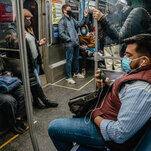
Why Hasn’t the U.S. Asked for a Stay in the Mask Mandate Case?

The administration’s actions suggest either a botched case or a shrewd play for time as it gives up on the mask order but hopes to erase an adverse ruling, legal experts said.



WASHINGTON — Does the Biden administration really want and intend to fight for a higher court reversal of the ruling this week striking down its mask mandate on airplanes, trains and other public transportation — as its high-profile appeal of the case seemed to suggest?
Legal specialists raised another possibility: The administration may instead be buying time and thinking about trying to erase the ruling — a move that would allow it to protect the powers of the Centers for Disease Control and Prevention to respond to a future crisis — but without reviving a mask mandate.
The tell, several outside specialists said, was that the Biden administration was letting days pass without seeking a stay of the ruling, the step that could most immediately resurrect the mask requirement.
“Basically, it is giving up on the mask mandate,” said Lawrence O. Gostin, a Georgetown University professor of global health law who advised the White House on the case. “The administration’s goal is a legal principle, which is to ensure that the C.D.C. has strong public health powers to fight Covid and to fight future pandemics. And it appears much less important to them to quickly reinstate the mask mandate.”
In fact, the administration has shifted away from masks as critical to the pandemic fight for two months. President Biden and other top officials have increasingly presented masks as a matter of personal choice, not federal policy.
The requirement to mask on public transportation, put in place soon after Mr. Biden took office in January, has been the exception. It was set to expire May 3, but with rising infections nationwide, the C.D.C. had left open the possibility of extending it again before the federal judge, Kathryn Kimball Mizelle of the Middle District of Florida, struck it down on Monday.
Amid fluid deliberations about what to do, Karine Jean-Pierre, the principal deputy White House press secretary, told reporters that the administration was appealing because “the C.D.C. must have the essential public health authority” to make critical decisions now and during future health crises.
“That is what is at stake right now,” she said.
Because the case turns in part on whether the C.D.C. was justified in enacting the mandate as an emergency measure that offered no room for public notice or comment, it is notable that the administration appealed the ruling while not seeking an immediate stay. The failure to try to keep the mask order in place could undercut the government’s argument that there was an urgent need for the requirement; otherwise it would have tried to keep it in place, legal specialists say.
If the government really wanted to fight its appeal all the way to a decision on whether to overturn Judge Mizelle, said Stephen I. Vladeck, a University of Texas at Austin law professor who specializes in federal courts, “then they totally botched this, because it’s Thursday and the ruling was on Monday and they haven’t done anything about it yet.”
But Mr. Vladeck contended that the failure to seek a stay may make sense if the Biden legal team was instead trying to protect the C.D.C.’s power with no real intention of trying to get a higher court to reinstate the mask mandate.
He pointed to an obscure legal doctrine under which if a case is on appeal when the dispute becomes moot for reasons unrelated to the litigation, an appeals court can remand it to the district court with instructions not only to dismiss the case but to vacate the district court’s ruling — meaning wipe it from the books.
The government, he said, may be giving itself that option after the mandate’s planned expiration on May 3.
Image
In her ruling, Judge Mizelle put forward a cramped interpretation of the agency’s regulatory powers to protect against the interstate spread of infectious diseases. Both she and a majority of the appeals court that oversees her court were appointed by President Donald J. Trump, whose legal advisers openly promoted their search for potential judges who would be skeptical of the power of regulatory agencies.
Asked by a reporter on Thursday why the Justice Department had not sought an immediate stay, Attorney General Merrick B. Garland called that “a tactical strategy question.” Giving no further explanation, he said the matter would be resolved by litigators in the Justice Department.
But, he added, “our reason for appealing is we believe that the C.D.C. has clear statutory authority for the mask mandate, and the C.D.C. has assessed that it is necessary for the health of the American people — particularly the traveling public.”
Michele Goodwin, a law professor who specializes in health policy at the University of California, Irvine, said the standards for winning a request to stay a judicial order can be even higher than for an appeal. Fighting for one and losing it, she said, would raise particular risks of an appeals court decision that could take a similarly narrow view of what the C.D.C. may do in a public health crisis — and that, unlike a district court ruling, would also be a binding precedent.
“Losing sends a very strong message, and not just for the matter that happens to be at hand, but for other cases related to public health and safety,” she said.
The C.D.C. said on Wednesday that masking remained necessary to protect the public health of passengers on planes, trains, buses and subways, and a recent poll showed that 56 percent of Americans support the requirement. But airlines have called for an end to the requirement for months. And aside from public transportation, the administration has been deliberately moving away from masking as an essential pandemic tool for weeks.
Asked on April 11 why Mr. Biden wore a mask the previous weekend while Vice President Kamala Harris had stood over him maskless at an event, Jen Psaki, the White House press secretary, said it was up to each person to decide what to do.
“We all make decisions. Some people in here are wearing masks to make them more comfortable, or because they chose to that day,” she said, perhaps because they will be around family members or others who are particularly vulnerable. “And the president makes that decision, as we all do as well.”
In late February, the C.D.C. changed its guidelines in a way that made it far less likely that a county would be considered high risk, and specified that it recommended indoor mask-wearing in high-risk areas. In areas of moderate risk — like Manhattan and Washington, D.C. — those who are particularly vulnerable to severe illness from the virus should talk to their health care providers about whether to wear a mask, the revised rules say.
“Our emphasis right now is on getting people information and tools they need to make decisions for themselves,” Dr. Greta Massetti, a senior epidemiologist who is helping lead the agency’s pandemic response, said in an interview last week. Those choices should be “based on their own personal level of risk and their risk tolerance,” she said.
Sheryl Gay Stolberg and Katie Benner contributed reporting.
Source: https://www.nytimes.com/2022/04/22/us/politics/biden-legal-strategy-mask-mandate.html
















